China's new—and as yet unnamed—spacecraft safely returned to Earth on Friday after a three-day mission. Under the care of three parachutes, the spacecraft came to a rest in a Chinese desert at 1:49am ET (05:49 UTC). Images released by the Chinese space corporation showed a singed but intact spacecraft.
For China this was a historic flight, sending an uncrewed prototype of its next-generation spacecraft to an altitude of 8,000km. The mission also served to test a new variant of the country's most powerful rocket, the Long March 5B, which also was deemed a success.
According to Space News, the spacecraft's reentry velocity was 9km/s as it approached from a higher orbit. This is on par with the high-speed return made by NASA's Orion spacecraft during its uncrewed Exploration Flight Test-1 mission in 2014, when the capsule reached a peak altitude of 5,800km.
China has not outlined, in detail, the scope of its ambitions for human exploration during the next decade. However, it plans to use its new Long March 5B rocket to construct a modular space station in low-Earth orbit over the next two to three years. One version of this new spacecraft, with a mass of 14 tons and a striking resemblance to SpaceX's Crew Dragon, is likely to play a role in delivering up to six crew members at a time into space for that purpose.

In addition, the China Aerospace Science and Technology Corp. now also has a vehicle capable of taking humans into deep space—and possibly to the Moon. The reentry velocity for a spacecraft returning from the Moon is just under 11m/s. And a larger version of this spacecraft, with a mass of more than 21 tons, Read More – Source
[contf] [contfnew] 
arstechnica
[contfnewc] [contfnewc]







